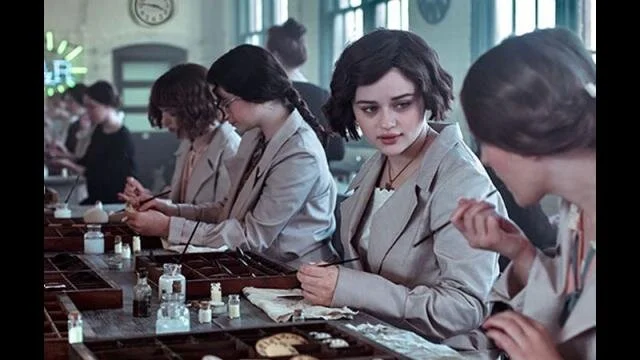"Radium Girls" film strikes close to home
ILHS
Imagine ingesting a known carcinogen onto your lips, hundreds of times daily, all part of your work routine.
In central Illinois the “Radium Girls” at the Radium Dial Company in Ottawa is a well-known and tragic story. Young women were hired to paint radium onto watch and clock faces, so they would be visible at night.
Recently, a new film, Radium Girls, tells the story of the unfolding tragedy and how young working class women finally found a voice to stand up to their bosses.
Ten years before the Ottawa court cases exploded in the news, 100 young women at the U.S. Radium Corporation in Orange, New Jersey, painted the clock faces, paid approximately one and one-half cent for each dial completed. The plant opened during World War to provide luminous watches for the military. The women used fine camel hair paint brushes and were encouraged to maintain a fine point on the brush by twirling it on their lips. Chemists and managers avoided the radium and used lead shields but there was no protection for the young female workers. The company did not end the hand painting of clock faces until 1947.
In this semi-fictionalized film, Italian immigrant daughters, Josephine (Abby Quinn) and Bessie (Joey King) Cavallo work at the plant. An older sister, Mary, who also worked at the plant, had already died. Josephine is becoming anemic and beginning to lose her teeth, a common malady of the plant workers. Because they were told the paint was safe, the young women often paint their nails and faces with the toxic poison. Both girls are wrapped up in a 1920s fad, studying ancient Egypt. As Josephine sickens, naïve but earnest Bessie starts to ask questions. The workers are photographed by Walt, a young Communist who develops a relationship with Bessie and exposes her to the wider world’s injustices. Josephine is reclusive and virginal – a company doctor comes to examine her and gives the same diagnosis he labels every sick woman from the factory with – syphilis.
With the help of the Consumers League, the women find a lawyer in 1928. Bessie is harassed for her efforts and shunned by other women, fearing for their jobs. The media descends on the courtroom and the women’s affliction gathers favorable media attention. The film ends as the real case ended, an out-of-court settlement for $10,000 each for the five women plaintiffs (about $150,000 in today’s dollars).
As the story in New Jersey unfolded, Ottawa workers were told that the New Jersey had viral infections and the paint was safe. Ten years later the Ottawa women were in court, ravaged by radium and seeking justice.
The film is worth the watch for two reasons – first, to realize the corporate malfeasance and treachery that is a too common story but also, to see young, isolated working class women find their voice and fight for injustice.
The film was originally scheduled for theatrical release in 2020 but was delayed because of COVID. It is available on Amazon for rental for $4.99 at https://amzn.to/2L4CLWL The film’s executive producers are Lily Tomlin and Jane Wagner.
Mike Matejka
